Boarding the ferry for the hour long sailing to Shodoshima was a pleasure after our struggles on the trains. Our bikes were not only secured with wooden blocks behind the wheels, they were also carefully secured by ropes with protective cloths over the frames! This was all done for us, while we watched in admiration (and thoughts about frantically securing our bikes on BC ferries!)
We had booked a room at the ryokan Tanku Hotel Kairo, which we found perched on top of a hill. We appreciated the view later, if not the steep road up! The hotel was rigid about check-in time, so we dropped our bags and headed (back down) for lunch at a local ramen restaurant. The noodles and boiled egg were very good. We sat outside overlooking the sea and Angel Road, a string of small islands joined at low water by sand bars. After lunch, we walked along Angel Road just before the tide came in.
As the forecast for the next day was for rain, we decided to cycle a few kilometres out of Tonosho to Nakayama to visit the Lonely Planet recommended “thousand rice fields” – multiple terraced rice fields, irrigated by spring water and believed to have been built between the 14th and 17th centuries. There, we also discovered an active traditional thatched Kabuki theatre, one of only two surviving from the Edo era. Kabuki is classical stylized Japanese dance drama, but unlike major Kabuki shows, the actors, narrators, makeup artists and stage carpenters of the Shodoshima theatres are all local residents. In the costume storage house, 350 scripts and 720 costumes are stored and available for use.
Arriving back at the hotel, we discovered that dinner had to be reserved ahead of time. So, it was cheese and crackers again, plus some local green olives we had bought when we stopped for ice cream, which we ate on our tatami mat sitting area looking out over the sea.
It did rain the next day, but was limited to intermittent light showers so didn’t interfere with our sight-seeing. The Japanese rainy season, tsuyu, begins between the end of May and mid-June, depending on the region. On the way up to the Olive Garden another cycle tourer caught up with us. We had noticed him on the Shimanami Kaido, going in the other direction. He lives in Wellington, NZ and was on a two week vacation. Like us, he was taking advantage of ferries to avoid cycling on busy highways.
The Olive Garden is where the island’s olive growing activities are celebrated. Since the early 20th C Shodoshima has been a top producer of Japanese olives and olive oil, and has earned the nickname “Olive Island”. We left our bikes and wandered through the groves and took photos of play structures designed by Japanese American sculptor and landscape artist, Isamu Noguchi. The gift shop was replete with foods and other products made using olive oil. The olive chocolate was delicious!
On the way back, we stopped at The Style Shop Mother’s on another citrus fruit and olive farm. The restaurant served really wonderful freshly squeezed juice from local Hassaku oranges. It is a citrus hybrid, orange in colour but grapefruit in size. The taste was more bitter than an orange. In the shop, we sampled their olive oil, including a dressing blended with mandarin oranges. Unfortunately, they do not ship out of Japan!
In between the farm visits, we stopped in Sakate, where the air was heavy with the fragrance of soy sauce. At a small manufacturer, we sampled a local soy sauce on its own and one mixed with garlic olive oil. Then, we went on to the Marukin factory where there is an informative display about the 400 year-old history and production of soy sauce on the island. Finally, we had soft-served soy sauce ice cream, which is salty and surprisingly good. On the way back, we missed the turning where we had planned to also sample local plum ice cream!
Dinner at the hotel was another excellent multi-dish meal, served ryokan style, including rice with fish cooked in an iron pot at the table.
Paul is reading American anthropologist Ruth Benedict’s book, The Chrysanthemum and the Sword (a recommendation by Rory). Benedict’s study was commissioned by the U.S. government after WWII to aid in understanding Japanese actions both during and after the war. While it has been criticized by some as being too narrow and definitive, it remains a useful introduction to Japanese culture. Benedict describes the ethical code requiring extreme repayment of obligations and drastic renunciations. However, she observes that the Japanese consider physical pleasure good and worth of cultivation. “One of the best loved minor pleasures… is the hot bath”. Soaking in our separate (male and female) outdoor onsen, with the rain gently falling, we would agree!
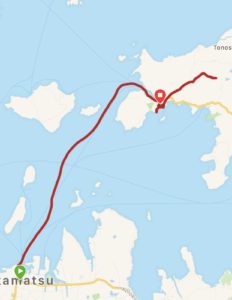
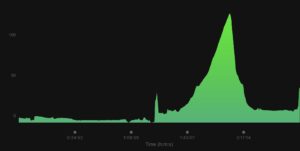

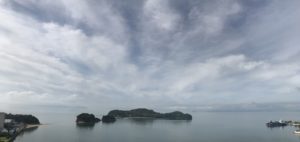
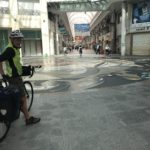

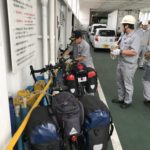





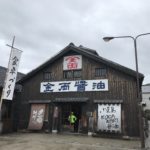

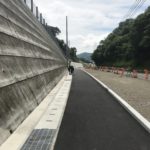

glad you enjoyed the island,, and that it was bike friendly is certainly a bonus! and great bike service on the ferry… I’m happy you’re getting to see that aspect of japan,, it really is remarkable.
when we camped on shodoshima, we found an abandoned hotel, high on the mountain..(car only!) built during the bubble economy. i snuck in, much to my wife’s dismay, and found everything left exactly as it had been decades ago…errie! still food in the restaurant, sheets and pillows on the beds. they had just gone bankrupt and everyone left,,the door wasn’t even locked!! i kept expecting someone to pop up from behind the front desk..now that would be service! apparently, these are all over japan, fear of ghosts keeps most people away.
enjoy the rest of your trip,,don’t let tsuyu get you down!
…and we thought that ourhotel was quiet!